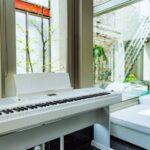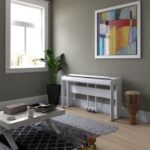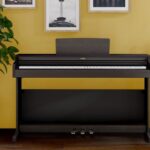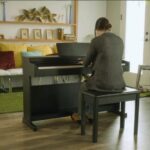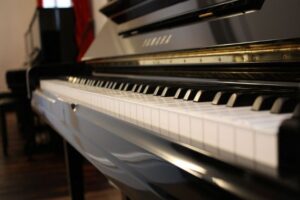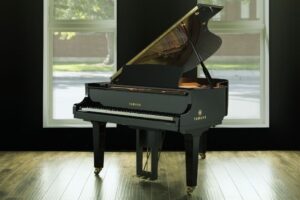Yamaha introduced the P71 digital piano in 2016. The slim and stylish design, along with 88 fully weighted realistic keys, makes the Yamaha P71 perfect for beginners or more experienced pianists.
The keys are graded hammers which means they have soft/medium/hard touch sensitivity. It comes with a headphone jack, USB host, a pedal, 64 notes, and duo dual modes.
The Yamaha P71 Digital Piano operates on a tempo range of 32-280, with 4 types of reverb and AWM (Advanced Wave Memory) sound engines or stereo sampling tone. It is an affordable beginner-friendly piano with 10 instrument voices.
Read on to learn more about the Yamaha P71 Digital Piano, its specs and features, as well as its pros and cons.
Also, take a look at the P71 on Amazon to see its price and great reviews:
Click here to see it on Amazon.
About the Yamaha P71 Digital Piano
Yamaha Corporation released the Yamaha P71 Digital Piano in 2016 and recommended it for beginners. The piano features a graded hammer digital keyboard for realistic sounds and 10 different instrument voices. It is a good choice for professionals too.
The P71 model features 64 polyphonic notes, 4 types of reverb, and dual-mode with a tempo range of 32-280. The keys are soft-touch sensitive and come with a headphone jack portal, USB host, and pedal.
Yamaha P45 vs P71 – How Are They Different?
Yamaha P71 Digital Piano Specs and Features
1. Keyboard
The Yamaha P71 is equipped with 88 GHS weighted keys that give a heavy touch on the keyboard’s low end and acoustic sound on the high end. It gives the real feel of an acoustic piano. The weighted keys build finger strength to improve the piano playing techniques of musicians.
The keys are susceptible to touch. It has 4 levels of touch: soft, medium, hard, and fixed. The harder you press the keys, the louder the sound you get. You can hear melodies going up and down when hitting the keys.
2. Sound and Voices
The Yamaha P71 features Advanced Wave Memory (AWM) sound engine for rich and deep sounds, with 64 polyphonic notes and 10 instrument voices. The voices are 2 electric piano voices (vintage and FM synthesis electric piano sound), 2 grand piano voices (concert and bright piano sound), 2 pipe organ voices, strings, vibraphone, and 2 harpsichord voices.
The Yamaha P71 includes 4 chorus and reverb options such as Room, Stage, Hall1, and Hall2 to add to various sounds.
3. Functions
Dual Mode
The Yamaha P71 operates on dual-mode. These are split mode and duo mode. The duo mode allows you to play two instruments at the same time. Say you want to play piano voice with strings – you can do that easily by just pressing buttons on your piano.
The 88 keys are divided into two, each with 44 keys and a middle C in duo mode. This mode allows the teacher and student to play at the same time.
Metronome
The Yamaha P71 features a metronome that allows you to program the speed intervals you need while practicing. You can choose to have prolonged, breakneck speeds.
Transpose
The Yamaha P71 digital piano has 6 to 0; 0 to +6 transpose capability that allows you to change your piano pitch.
4. Recording Feature
The Yamaha P71 Digital Piano features a recording capability that allows recording executions and training that you can review after improving your output.
5. Controls
The Yamaha P71 provides various digital piano functions with ease, such as volume capacity controls, compatibility controls with devices, namely iPhone and iPad. It also features sound setting controls. You can choose from the pre-programmed tunes and listen to demo songs.

6. USB Ports
The Yamaha P71 provides USB ports, such as an audio-out port, a MIDI port that uses a five-pin cable. The MIDI port and USB audio port can send MIDI and audio data with a USB A to B cable.
A USB MIDI port can send MIDI data only via a USB A to B cable, while an auxiliary port is used to connect an audio cable.
Also, the piano offers ports for earphone ports, frills, and other external devices port like a personal computer.
7. Connectivity
The Yamaha P71 features simple and varied connectivity options, such as connecting your piano to the internet or your keyboard to a computer, or your piano to external speakers. You could connect your digital piano to amplifiers, PC, iPad, and Android devices for your different purposes too.
The Yamaha P71 is also equipped with a headphone jack for audio output and a power adapter. You can also connect the speaker and amplifier with the audio output.
8. Auto Power
The Yamaha P71 includes Auto Power Off. The Yamaha P71 automatically shuts off on its own after some time to ensure safety and conserve electricity. You can disable these features if they are getting in your way.
9. Design and Quality
The Yamaha P71 Digital Piano features characteristics that are unique to this digital piano. This model is simple and elegant. It is compact with a depth below 12 inches and weighs 25 pounds only.
These properties render it easy to accommodate in your studio or house. Even with their small size, these are endowed with rich and complete features that make piano playing enjoyable.
The Yamaha P71 carries a brand leader’s reputation in manufacturing pianos and assurance for quality and impeccable design.
Take a look at the P71 on Amazon to see its price and great reviews:
Click here to see it on Amazon.
Pros and Cons of the Yamaha P71 Digital Piano
Pros
1. Impressive Design and Quality
The P71 Yamaha has a slim design and durable build quality. The keyboard, recording features, sound, connectivity, USB Ports, controls, functions features, and other parts are designed to the highest quality standards.
Yamaha made the P71 light and compact. So you can find a suitable place for it in your house or studio. Due to its lightness, you can move it easily.
2. Outstanding Keyboard
The Yamaha P71 88-key is wholly weighted to produce a grand piano sound and allow you to reinforce the correct piano technique. Graded hammers make the keys weighted to give you the feel of a grand piano as you play.
3. Resonating and Authentic Sound
The Yamaha P71 produces a resonating sound by combining the weighted keys and the pressure you put on them. So, as you press harder, the sound becomes louder.
4. Rich Piano Music
The dual-mode of the Yamaha P71 renders rich melodies with its 64 notes and ten voices. The use of the voices from different instruments creates melodies that are pleasing to the ear.
5. Simple and Easy to Use
Even a beginner can manipulate the functions of the Yamaha P71 since these are simple and easy to use. The duo mode function to play two instruments at the same time.
Its metronome allows you to adjust the speed during training. With its transpose capability, you could adjust the pitch of the piano.
6. Easy to Move Around
The decreased dimensions and weight of the Yamaha P71 make it easy for pianists who are constantly on the go. Professional musicians probably need a more-feature piano since they may require more polyphonic notes than what is provided by this model.
Cons
1. Lacks LED Display
The Yamaha P71 does not include a LED display. This disadvantage restricts a piano player from personalizing the effects and the audio use.
2. Limited Audios
Features and audios are limited to a beginner. Therefore, if you move up with your capability, you may need a piano with improved features befitting your skill. For professional players, this may not be the best option.
Tips on How to Maintain Your Yamaha P71 Digital Piano
1. Clean Regularly
- Wipe your piano with a dry clean cloth. Never use a wet cloth over your piano.
- Avoid dropping liquid on your keyboard.
- Wipe your hands dry before you play the piano.
- Keep it covered to prevent dust from accumulating on your piano
- Do not use abrasive cleaning chemicals, and these will damage your keyboard and overall packaging of your piano
2. Store It in a Safe Place
Find a safe place for your P71. In doing so, be sure to follow the tips below:
- Avoid areas that are open to too much foot traffic. The tendency of it getting hit and bumped by people
- Be sure to place your piano in a shaded area to avoid exposure to moisture, sunlight, and water.
- Avoid places that are near heat-emitting appliances and devices. Ensure a distance of about 4-5 meters from stoves, computers, and heaters
3. Use It Properly
Your Yamaha P71 is a piano, not a shelf, where you can deposit things on or use it as a table for your work or your kids’ assignments.
Do not use it as a shelf, table, mini bar, dining table, and do not lean on it. This is a piano that you must use only to play music.
4. Unplug When Not in Use
Many had their piano damaged for not observing proper plugging and unplugging of their pianos. Take care of it as your most precious device. Always make sure your Yamaha is unplugged after use.
Avoid placing your Yamaha wires and cords where people can trip and accidentally pull them. This mishap could cause your piano to fall and get damaged. Ensure that the outlet you are using can accommodate your Yamaha P71 without overloading.
Avoid plug-sharing with electrical appliances. These shared outlets could overload and cause electrical accidents.
You must also avoid placing heat-emitting devices besides your piano. These devices can affect the sound of your instrument.
5. Protect It
Protect your Yamaha P71 at all times before, during, and after use. Damages can happen at any time.
Be sure always to cover your keys. Dust is a potentially damaging element since it can reach the most sensitive part of your piano and affect its performance.
Turn off your piano after use. Do not leave it on. The prolonged connection to electricity can affect the piano’s overall performance.
Pets are a big ‘no’ on your piano. Do not place them on top of your piano. Their hair may get into the sensors that can affect the piano’s performance.
6. Consult a Skilled Service Provider

Make sure to bring your Yamaha P71 to the Yamaha center in your area so that a skilled professional Yamaha service member can inspect it. Avoid unauthorized service providers as they may damage your piano since they are not familiar with your piano features.
Conclusion- Yamaha P71 Digital Piano
The impressive design and quality of the Yamaha P71 Digital Piano make it a great choice for beginners or more experienced pianists. The graded hammer keyboards of 88 weighted keys could produce rich music to compare to the acoustic piano’s sounds.
The compact and reduced size and weight make it easy to move around. Its polyphony of 64 notes and 10 instrumental voices with 4 reverb settings provides an easy method for beginners to learn.
The Yamaha P71 features, functionality, and design are the same as the P45. The only difference is the exclusive labeling of P71 for Amazon. If you own a Yamaha P71 Digital Piano, you got the best buy in the “P” series of Yamaha manufactured pianos.
Related reading:
Yamaha P45 Vs P71 – What Is the Difference?
Yamaha U Series Upright Piano Specs and Review



